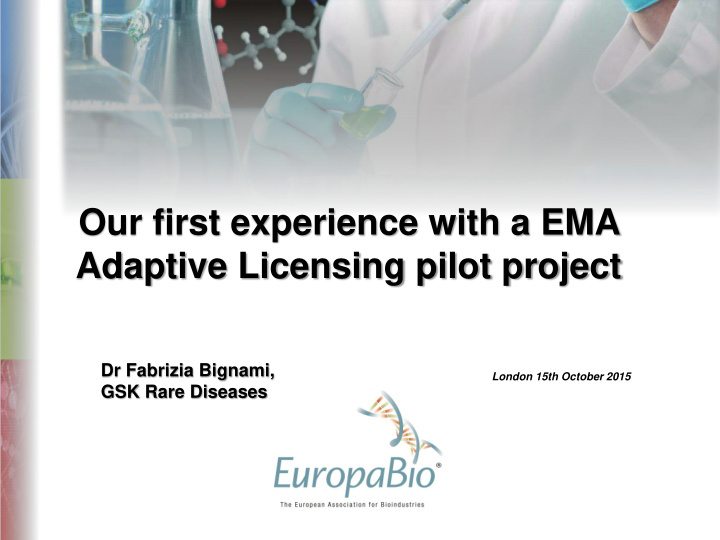



Our first experience with a EMA Adaptive Licensing pilot project Dr Fabrizia Bignami, London 15th October 2015 GSK Rare Diseases
Adaptive Licensing: for which medicine • Life threatening or severe condition that justifies early access • Ability to clearly define a (sub) population which anticipates the best benefit risk balance for the initial study • Ability to define a robust surrogate endpoint • Ability to restrict access to this population in the initial marketing setting • Availability of the ‘expansion’ populations
Case study: GSK2315698 (small molecule SAP* depleter) and GSK2398852 (anti-SAP mAb) • Investigational medicines for the treatment of systemic amyloidosis (AL amyloidosis) • Disease caused by amyloid deposition in key organs − Amyloid accumulation leads to progressive organ failure − Heart and kidney prognostically most important • Anti-SAP mAb binds to Serum Amyloid P component (SAP) decorating amyloid fibrils = drug target − GSK2315698 depletes SAP in plasma (leaves some bound to fibrils) − GSK2398852 anti-SAP mAb binds to SAP o complement and macrophage clearance of amyloid restores organ function enabling treatment of underlying cause
Case study: GSK2315698 (small molecule SAP* depleter) and GSK2398852 (anti-SAP mAb) • The anti-SAP approach has the potential to improve functional status and therefore the ability to tolerate and receive other therapies addressing the underlying production of amyloid- forming protein • Anti-SAP treatment taken together with therapy addressing AL production has the potential to substantially alter prognosis Production of amyloid-forming Organ dysfunction that drives protein (monoclonal morbidity and mortality gammopathy) Treatment aimed at abnormal clone Anti-SAP mAb (chemotherapy/ stem cell transplant) Clinical Outcome
Challenges of traditional licensing approach Systemic amyloidosis: • A clearly defined condition, BUT clinical manifestations and natural history show great diversity: – AL, AA, ATTR – Differing patterns organ involvement – Varying stages of disease at presentation • Several approaches for clinical development: • underlying condition VS organ involvement • The obligate co-administration of both developmental medicines further complicates the traditional development
Adaptive licensing proposed approach • Initially studying a subgroup of patients with AL amyloidosis – AL represents ~80% of systemic amyloidosis patients (prev 1- 5/10000) • Possible to select initial patient population by clinical stage • Propose adaptive licensing based on a robust clinically meaningful surrogate in this restricted population – commitment to follow up to investigate how surrogate translates into long term survival • Defined nature of target population would allow for a focussed initial indication – treatment in specialist centres would facilitate this approach • This population would provide solid evidence to guide further development
Adaptive licensing proposed approach • Single Phase II and III trial using validated surrogate markers • Named Patient Registry – follow-up for safety and to survival/PFS clinical endpoint • Retreatment data • New patient registry • Access limited to specialist treatment centres and specific diagnostic criteria • Commence Phase III in other subpopulations as results dictate
The EMA pilot experience • Pilot Project launched in March 2014 • Our programme selected as a pilot • Meetings of the Adaptive Licensing Discussion Group (ALDG) • The discussions cannot be considered a formal advice: there is no in-depth discussion of scientific aspects, which is within the remit of a formal SA/PA procedure. It is a high-level early dialogue led by the SAWP chair and assigned coordinators to review the plausibility of the development plan and guide to the next – more formal - regulatory steps • An HTA/SA parallel advice, shaped by this initial discussion • Stakeholders to be involved in the procedure should be identified by the Applicant.
Challenges of Adaptive Licensing • Managing off-label use • Communicating benefits and risks to prescribers and patients • Withdrawing indications or products • Ensuring a predictable and attractive NPV • Securing market access at a price that reflects the potential value • Investment post-launch • Length of product life • Not always adapted for rare diseases
Personal views on Adaptive Licensing • Real potential to streamline drug development and access for patients. • Enables early alignment of perspectives :Regulators, Patient Experts, Clinicians, HTA, Sponsor • Leads to early access and knowledge acquisition • May result in more sustainable development: lower costs; earlier revenue generation However... • Misunderstanding on level of guidance companies may receive • Advice is not binding • Concept not universally accepted • HTA and pricing still disconnected • Any lessons to learn from FDA Breakthrough designation approach?
Thank you for your attention!
Recommend
More recommend